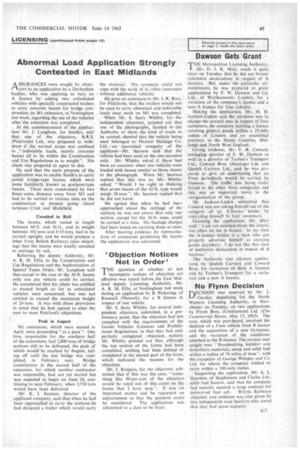Abnormal Load Application Strongly Contested in East Midlands
Page 49

If you've noticed an error in this article please click here to report it so we can fix it.
A SSU.RANCES were sought by objecrNeors to an application by a Derbyshire haulier, who was, applying to vary an A licence by adding two articulated vehicles with specially constructed trailers to carry concrete beams for bridge construction On MI extension; at Nottingham last week, regarding the use of the vehicles after' the extension Was completed.' • . At the commencement of the application Mr, J. Langham, for Smith's, said that one . of the objectors, B.R.S. (Pickfords) Ltd., Was prepared to with: draw if the normal scope. was confined _ to e" indivisible loads, Mainly concrete beams all to be within the Construction. and.Use Regulations as to weight", His client was prepared to agree to this. .
He said that the main purpose of the application was to enable Smith's to carry portal bridge-type beams, which were more familiarly known as goalpost-type beams. These were constructed by two firms.soune distance away from MI and had to be carried to various sites on the construction at present going ahead between Crick and Markfield.
Unsuited to Rail
The beams, which varied in length between 60 ft. and 36 ft., and in weight between 101 tons and 6.33 tons, had to be carried upright, and he would produce a letter from British Railways (also objecting) that the beams were totally unsuited to carriage by rail.
Referring the deputy Authority, Mr. A. R. M. Ellis, to the Construction and Use Regulations and the Authorization of Special Types Order, Mr. Langham said that except in the case of the 36-ft. beams only one per vehicle could be carried. He considered that his client was entitled to exceed length so far as articulated vehicles were concerned, but was not entitled to exceed the maximum weight of 24 tons. It was with those provisions in mind that he had agreed to alter the user to meet Pickford'i objections.
Peak in August M1 extensions, which were started in April, were proceeding "at a pace". One firm, responsible for the southern half of the extensions, had 3,800 tone of bridge sections still to be delivered, the peak of which would be reached by August, tailing off until the last bridge was completed, in February next. Bridge construction in the second half of the extension, for which another contractor was responsible, had not yet started but was expected to begin on June 24, continuing to next February, when 3,730 tons would have been delivered.
Mr. K. I. Searson, director of the applicant company, said that when he had been approached to carry the sections he had designed a trailer which would carry
the material. His company could not cope with the work of its other customers without additional vehicles.
He gave an assurance to Mr. J. R. Bray:for Pickfords, that the trailers would not be used to Carry abnormal and indivisible loads Once work on M.1 was completed.
When Mr. S. Seely Whitby, for the independent objectors, pointed out that one of the Photographs, handed to. the Authority to show the kind of loads to be carried, showed that the vehicle • being.
• used belonged to Heanor Haulage -Co.: Ltd.--an— associated company of the 'applicant—Mr. Seamen said thatthe. vehicle had been used on the one:occasion only. • Mr. Whitby. asked if ,there. had been an occasion when two vehicles were loaded with beams similar to those shown in the photograph. When Mr. Searson replied that this was so; Mr. Whitley asked, "Would I be right, in thinking that seven beams of the 42-ft. type would weigh 28 tons ", Mr. Searson replied that he did not know.
He agreed that when he had been approached about the carriage of the sections he was not aware that only one section. except for the 36-ft. ones, could be carried at a time. His haulage charges had been based on carrying three at once.
After hearing evidence by representatives of companies producing the beams the appIicat:on was adjourned.
'Objection Notices Not in Order'
THEquestion of whether or not incomplete notices of objection are effective was raised before the East Midland deputy Licensing Authority, Mr. A. R. M. Ellis, at Nottingham last week during an application by B. Pickering, of Ireneesall (Newark), for a B licence in respect of one vehicle.
Mr. S. Seely Whitby, for several independent objectors, submitted, in a preliminary point, that the objectors had not complied with the requirements of the Goods Vehicles (Licences and prohibi-. tions) Regulations, in that they had only partially completed objection notices. Mr. Whitby pointed out that, although the top section of the forms had been completed, nothing had been deleted or completed in the second part of the form, which indicated the reasons for the objection.
Mr. .1. Rodgers, for the objectors, submitted that if this was the case, "something like 90 per cent of the objectors would be ruled out of this court on the forms that I. have seen ". It was an important matter and he requested an adjournment so that the question could be considered. The application was adjourned to a date 'to be heed.
























































































































































